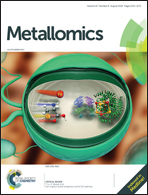Comparative metabolomic analysis reveals global cadmium stress response of Lactobacillus plantarum strains†
Abstract
Our previous work demonstrated the protective effects of Lactobacillus plantarum (L. plantarum) strains against cadmium (Cd) toxicity in vivo, and also indicated that the Cd tolerance of the strains played an important role in this protection. The goal of this study was to investigate the Cd resistance mechanism of L. plantarum by liquid chromatography-mass spectrometry (LC-MS) based metabolomic analysis, with a focus on the global Cd stress response. L. plantarum CCFM8610 (strongly resistant to Cd) and L. plantarum CCFM191 (sensitive to Cd) were selected as target strains, and their metabolomic profiles with and without Cd exposure were compared. The underlying mechanisms of the intra-species distinction between CCFM8610 and CCFM191 in terms of Cd tolerance can be attributed to the following aspects: (a) CCFM8610 possesses a higher intracellular content of osmolytes; (b) CCFM8610 can induce more effective biosynthesis of extracellular polymeric substance (EPS) to sequestrate Cd; (c) CCFM8610 can maintain a relatively stable nucleic acid metabolism to ensure normal growth of the strain upon Cd stress; (d) CCFM8610 exhibits a specific energy conservation mode to alleviate Cd-induced oxidative stress and/or adapt to the enhanced biosynthesis of EPS; (e) CCFM8610 has a more rigid cell membrane structure with a lower fluidity that can inhibit Cd influx into the cytoplasm.



 Please wait while we load your content...
Please wait while we load your content...